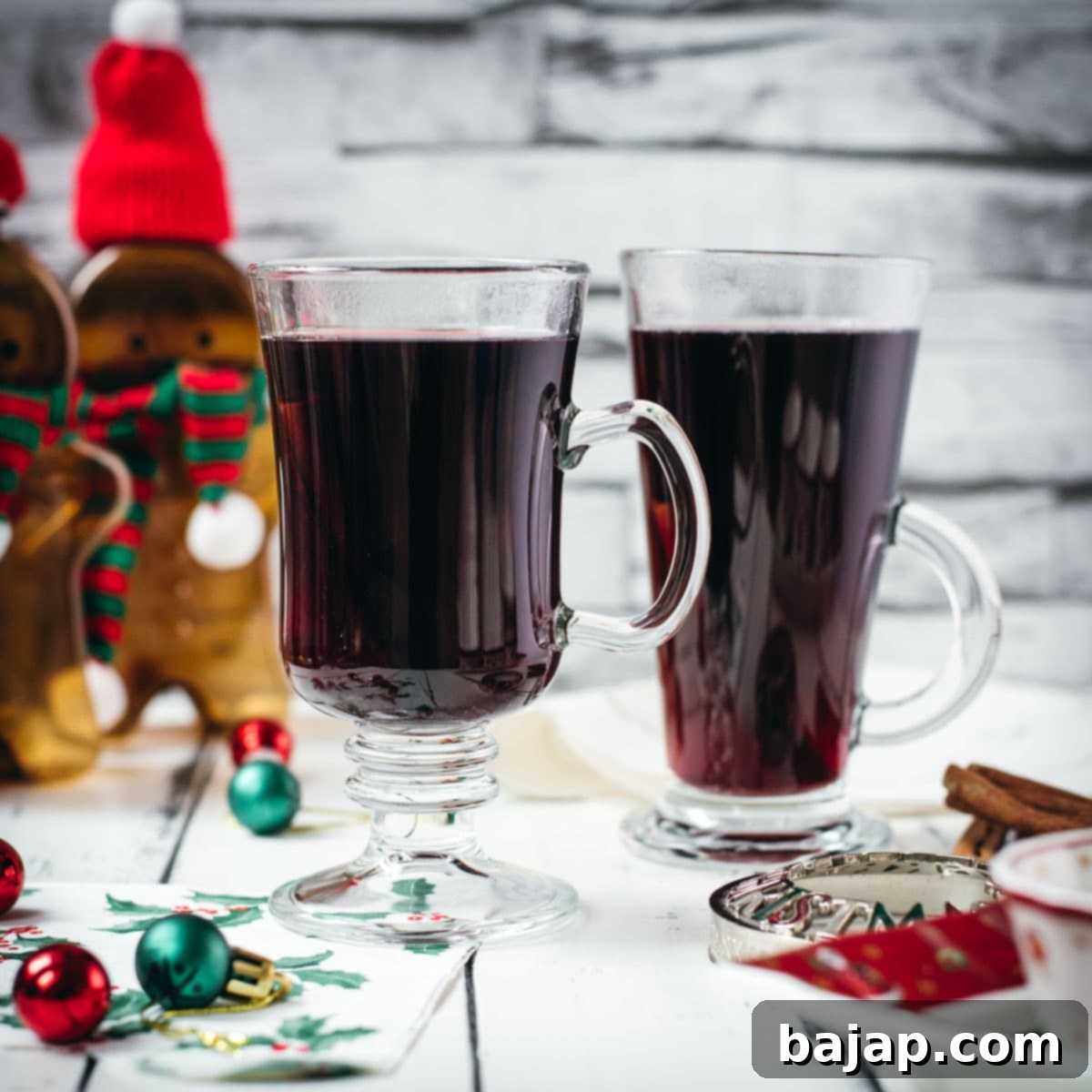Authentic Austrian Glühwein Recipe: Your Guide to the Perfect Christmas Mulled Wine
As soon as the crisp autumn leaves give way to the frosty breath of November, a magical transformation begins. My home, much like those across Austria, starts to fill with the warm glow of festive decorations and the irresistible promise of the holiday season. It’s a time when traditions take center stage, and here, our Christmas celebrations are deeply intertwined with the joyous spirit of Advent.
Among all the cherished customs, there’s one that truly captures the essence of Austrian Christmas for me: the enchanting aroma of Glühwein. This classic mulled wine isn’t just a drink; it’s a sensory journey, a liquid embrace that you’ll find simmering in every corner of our picturesque Christkindl markets, its spicy fragrance drawing you into the heart of the festivities.
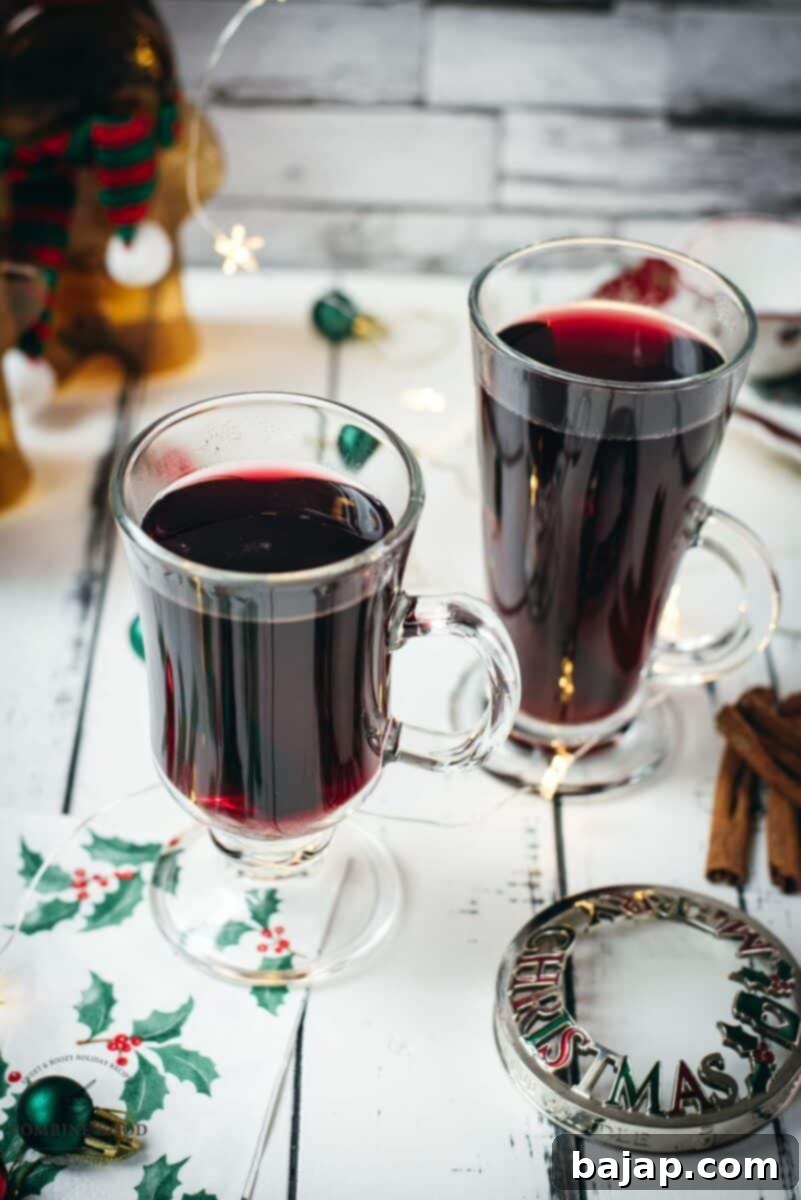
There’s an undeniable charm in wrapping your hands around a steaming mug of this fragrant, warming beverage, especially when you’re exploring the charming stalls of a Christmas market. Surrounded by twinkling lights, the cheerful chatter of holiday revelers, and the crisp winter air, each sip of Glühwein becomes a moment to savor. It’s more than just a drink; it’s a taste of centuries-old tradition, a comforting hug in a cup that brings friends and family closer, creating unforgettable memories during the most wonderful time of the year.
With today’s recipe, I’m thrilled to share my classic Austrian Glühwein, a simple yet authentic way to bring the heartwarming scents of cinnamon, cloves, and citrus directly into your home. Imagine your kitchen filled with the very aromas that dance through our bustling Christkindl markets. So, gather your loved ones, perhaps roast some chestnuts for an extra touch of coziness, and raise a toast to the season. Let’s make every sip a celebration as we embrace the magic of Advent together!
🥘 Simple Ingredients for Authentic Austrian Glühwein
Crafting the perfect Glühwein doesn’t require a long list of exotic ingredients. In fact, its beauty lies in the simplicity and quality of a few key components. Here’s what you’ll need to recreate this beloved Austrian mulled wine at home:
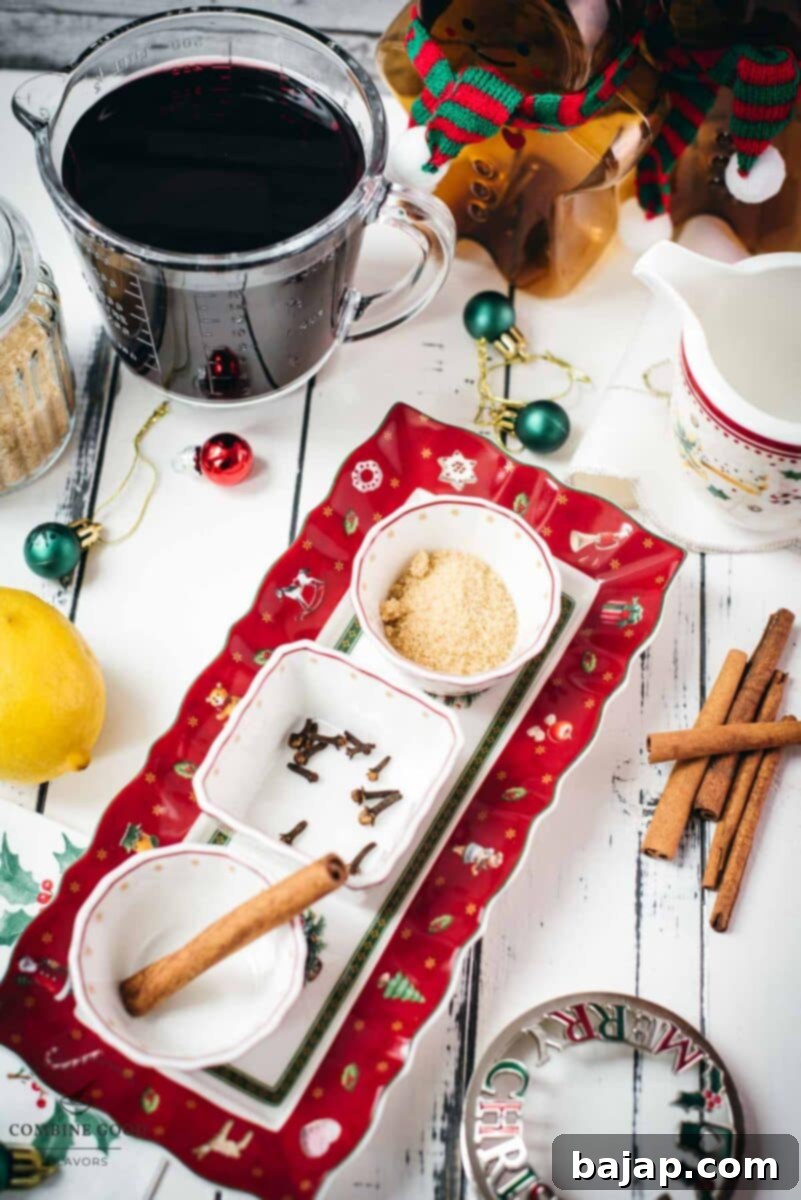
- Red wine: Opt for a full-bodied and fruity variety. Think Merlot, Zweigelt, or a Grenache. Avoid anything too tannic or heavily oaked, as these flavors can clash with the spices.
- Water: Just a small amount to help infuse the spices and temper the wine slightly.
- Cinnamon sticks: Essential for that classic warm, woody spice. You’ll use some for boiling and a fresh one for garnishing each glass.
- Cloves: A few whole cloves provide a pungent, aromatic counterpoint to the cinnamon and citrus.
- Lemon zest: Fresh lemon zest brightens the flavor profile, adding a vital citrusy note without making the mulled wine too sour.
- Brown sugar: To sweeten your Glühwein to perfection. The amount can be adjusted to your personal preference, making it as sweet or as tart as you desire.
For precise quantities and a printable version, please refer to the comprehensive recipe card further down the page.
🔪 Step-by-Step Instructions for Making Glühwein
Making homemade Glühwein is incredibly simple and rewarding. Follow these easy steps to create a delightful festive drink that will impress your guests and warm your soul:
Step 1: Infuse the Spices and Sweetener. In a sturdy saucepan, combine the water, fresh lemon zest, a few fragrant cinnamon sticks, and a handful of cloves. Add a generous spoonful of brown sugar. Remember, you can always add more sugar later, so start with a comfortable amount. Bring this mixture to a gentle boil over medium heat, allowing those warm, cozy holiday scents to slowly permeate your home. Let it simmer for a few minutes to ensure the spices are well-infused.
Step 2: Gently Warm the Wine. Once the spiced water is bubbling delightfully, pour in your chosen red wine. Now, this is the crucial step: gently heat the mixture, but under no circumstances let it come to a full boil! Boiling wine can cause the alcohol to evaporate too quickly and can diminish the delicate flavors of the spices. Instead, warm it just until it’s steaming and comfortably hot to the touch, ideally below 80°C (175°F). This preserves the complex aromas and the festive cheer.
Step 3: Strain for a Smooth Sip. Carefully strain the mulled wine to remove the boiled cinnamon sticks, cloves, and lemon zest. This ensures a beautifully smooth and clean sip, free from any chunky bits of spice.
Step 4: Garnish and Serve Immediately. For an elegant touch, slip a fresh cinnamon stick into each serving glass or mug. Then, carefully pour the steaming Glühwein over it. Serve immediately and enjoy the comforting warmth and vibrant flavors.
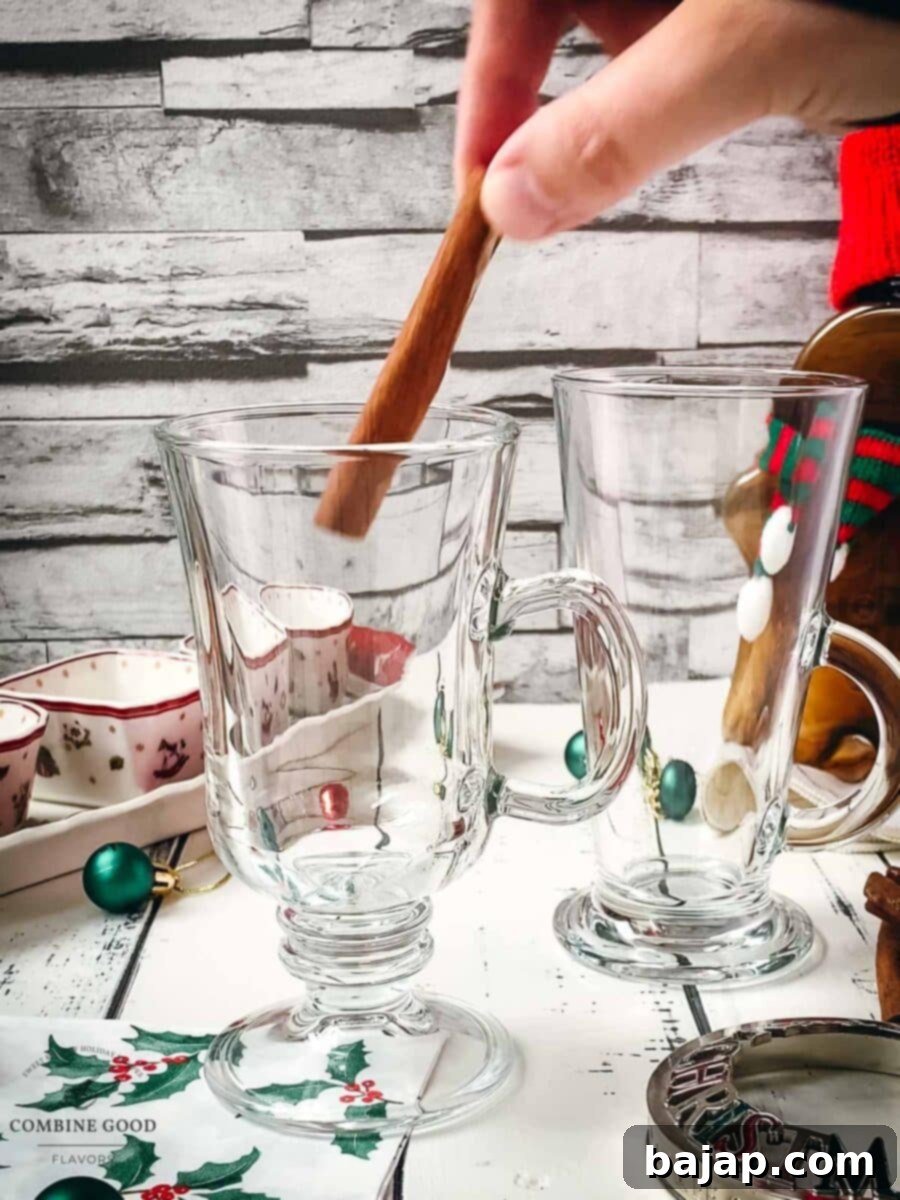
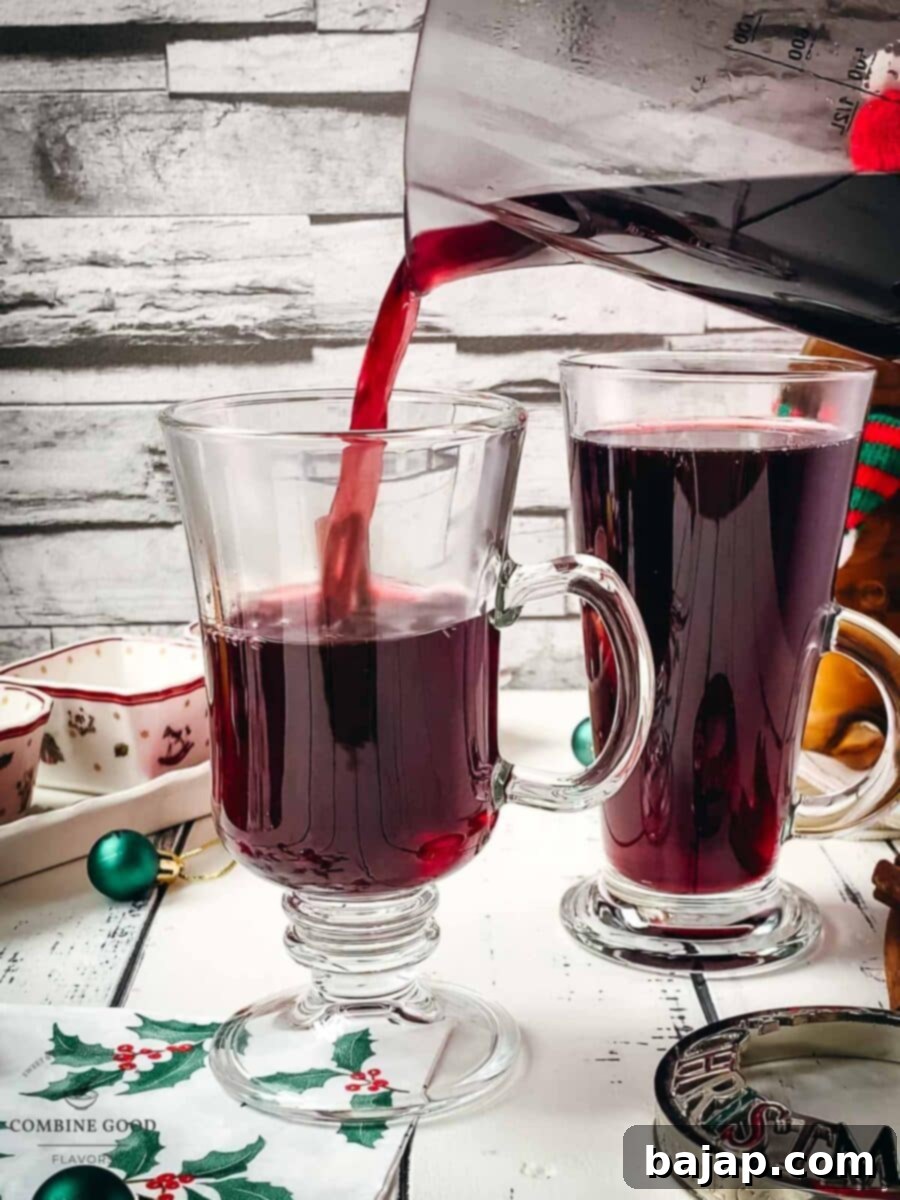
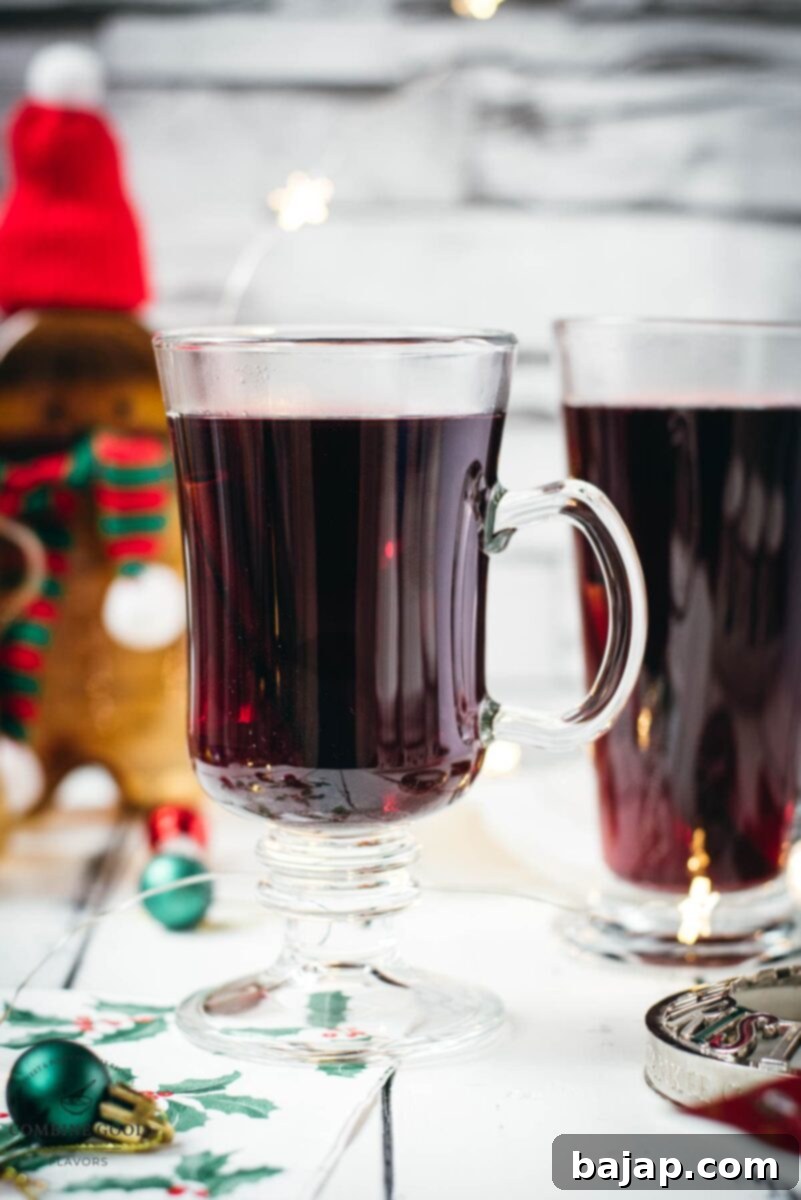
🎄 Glühwein: A Timeless Austrian Christmas Tradition
Glühwein, or mulled wine, is far more than just a drink in Austria; it’s a cherished symbol of the magical Advent season and the very heart of winter festivities. As soon as the Christmas markets spring to life, the air across cities like Vienna becomes thick with the sweet, spicy aroma of this delightful beverage. You’ll find steaming mugs warming the hands and hearts of festive shoppers, friends catching up, and families enjoying the holiday spirit. It’s an indispensable part of our cultural fabric during the colder months, a tradition passed down through generations.
While red wine Glühwein is the most iconic, it can also be made with white wine, offering a lighter, often fruitier alternative. The key, however, lies in the carefully selected spices: fragrant cinnamon, pungent cloves, often a hint of star anise, and the zesty brightness of citrus (lemon or orange). These ingredients are slowly infused and then sweetened to taste, creating a harmonious blend of flavors. The secret to a truly exceptional Glühwein is gentle heating – never allowing it to boil above 80°C (175°F). This careful process preserves the delicate nuances of the wine and the vibrancy of the spices, ensuring every sip is rich with complex aromas and festive cheer.
A Rich History, from Ancient Roots to Modern Cheer
The history of spiced wine stretches back to ancient Roman times, where it was enjoyed as “conditum paradoxum”—hot wine mixed with honey, dates, pepper, and saffron. This early form was often believed to have medicinal properties or was simply enjoyed for its enhanced flavor. During the Middle Ages, spiced wine remained popular across Europe, though it was more commonly served cold. Known as “Ypocras” (or Hippocras), named after the Greek physician Hippocrates, it was a staple at feasts, offering a way to preserve wine and make it more palatable.
It wasn’t until the 19th century that hot mulled wine truly gained widespread popularity in Vienna and other parts of Europe. Initially, it was a more English indulgence, but it quickly evolved into a beloved winter tradition on the continent. Interestingly, early doctors were often wary of the drink, sometimes even discouraging its consumption. However, its warming properties and delightful flavor soon won over the public, and by the late 1800s, hot spiced wines were being lauded as health remedies for common colds and the biting chill of winter. Homemaking magazines of the era were brimming with recipes for mulled wine and punches, cementing their place as seasonal staples.
Today, the tradition continues with vibrant enthusiasm. We gather, raise our mugs of Glühwein, and toast to the enduring spirit of Christmas, savoring a drink that connects us to a rich past and warms us in the present. It’s a taste of history, a hug in a mug, and a timeless reminder of holiday joy.
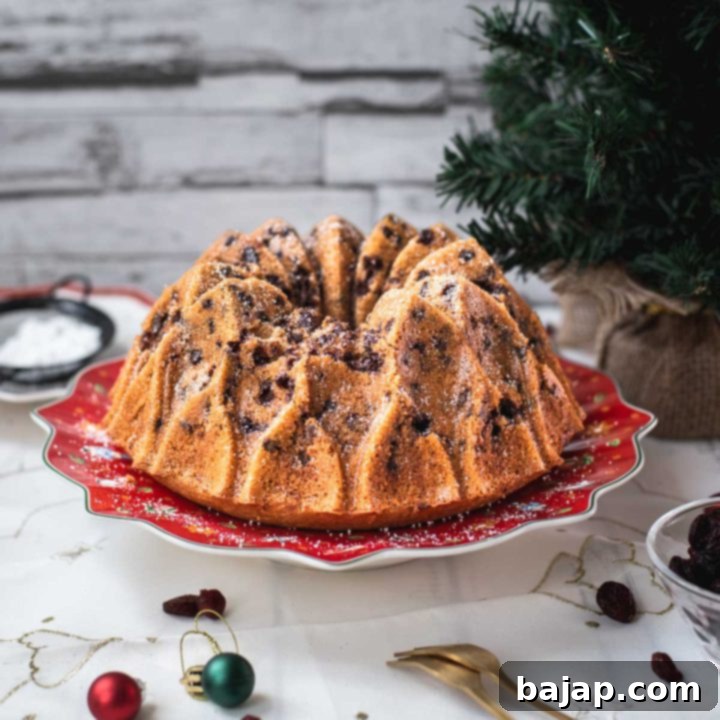
viral recipe!
Cranberry Bundt Cake
This Cranberry Bundt Cake is a delightful blend of cinnamon, dark chocolate chips, and dried cranberries that will surely satisfy your sweet cravings.
🥳 Celebrate Mulled Wine Day, Even Off-Season!
While the twinkling lights and festive bustle of Christmas markets are the quintessential setting for Glühwein in Austria, there’s a lesser-known, yet equally delightful, occasion to enjoy this spiced wonder: Mulled Wine Day on March 3rd! It might seem like an unusual date, far removed from the peak of the Advent season, but it offers the perfect excuse to rekindle that cozy, festive spirit.
As winter begins its slow retreat and we eagerly anticipate the arrival of spring, those last chilly days can still feel a bit stark. Mulled Wine Day provides a wonderful opportunity to bridge the seasonal gap. A steaming mug of Glühwein brings back the comforting warmth of mulled spices and sweetened wine, reminding us of cherished holiday memories and helping to fend off the lingering cold. It’s like a little taste of Christmas magic that extends the joy just a bit longer.
So, why not seize the day? On March 3rd, or any crisp day when you need a boost of cheer, stir up a pot of this classic drink. It’s an ideal way to keep the holiday glow alive, infuse your home with delightful aromas, and enjoy a warm, comforting beverage as you look forward to brighter days. It proves that some traditions are simply too good to be confined to just one season!

Christmas CookieBook!
Snag that Recipe eBook!
20 delicious Christmas Cookie recipes!
Yes, please!
🍷 Choosing the Best Red Wine for Mulled Wine
The foundation of any great Glühwein is, of course, the red wine. Making the right choice ensures your mulled wine is perfectly balanced and flavorful, rather than astringent or bland. When selecting a red wine for mulled wine, the key is to look for varieties that are full-bodied and wonderfully fruity, but with certain characteristics you’ll want to avoid.
Steer clear of wines with high tannin content, as these can become harsh and bitter when heated, overpowering the delicate spices. Similarly, wines with strong oak flavors, often found in heavily oaked Cabernet Sauvignon or some Zinfandels, tend to clash rather than harmonize with the traditional mulled spices. On the other end of the spectrum, light-bodied reds, such as Pinot Noir or lighter Beaujolais, often won’t quite do the trick; their subtle flavors can get lost amidst the robust spices and sweetness.
Instead, your ideal choice is a medium-bodied red wine with minimal oak aging. Think of varietals like a fruity Merlot, a robust Grenache, or even a local Austrian Zweigelt or Blaufränkisch if you can find one. These wines possess enough character to stand up to the warm spices and added sweetness without dominating them. A dry wine with balanced acidity and gentle tannins is paramount; this allows the rich, aromatic flavors of cinnamon, cloves, and citrus to truly shine through, creating a perfectly balanced and deeply satisfying cozy winter warmer. Good quality table wine, often referred to as “jug wine” in some regions, can also be an excellent and economical choice, as long as it fits the fruity and low-tannin profile.
🍽 Essential Equipment for Making Glühwein
You don’t need fancy equipment to whip up a delicious batch of Glühwein. Just a few basic kitchen tools will suffice:
- Saucepan: A medium-sized saucepan is perfect for simmering the spices and warming the wine.
- Grater for the zest: A fine grater or microplane to get fresh, aromatic lemon zest.
- Sieve: To strain out the spices for a smooth drink.
- Serving glasses: Heat-resistant mugs or traditional Glühwein glasses to enjoy your warm beverage.
🎄Other Christmassy Recipes and Tips for You to Try
- Raspberry Almond Thumbprint Cookies
- Snowball Cocktail
- No-bake Candy Cane Oreo Cake Pops
- Chocolate Chip Cookies with Chestnut Flour
- Coconut Busserl
- Marzipan Potatoes with Booze
- Zimtsterne
- Baking Basics for Christmas Cookies
- Festive Cranberry Gin and Tonic
- Easy Peppermint Bark
- Cranberry Gin Spritz
- Linzer Cookies with Egg Liqueur
- Cranberry Aperol Spritz
- Sweet Dips for Cookies
- How to decorate a real Christmas Tree?
–> more Christmas Recipes
If you make this authentic Austrian Glühwein recipe, I’d absolutely love to hear how you liked it! Please consider giving it a ★★★★★ star rating and leaving a comment below – your feedback is incredibly helpful and much appreciated. This would be awesome! You can also sign up for our Newsletter to receive weekly delicious homemade recipes, or follow me on Pinterest or Instagram and share your festive creation with me. Just tag me @combinegoodflavors and use the hashtag #combinegoodflavors, so I don’t miss it!
📖 Recipe
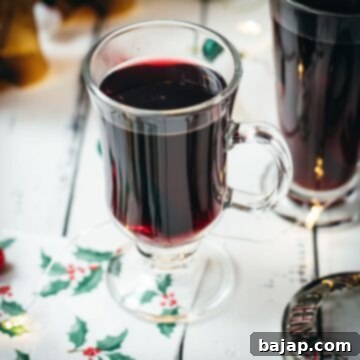
Austrian Mulled Wine
Nora
Save RecipeSaved!
Pin Recipe
Equipment
-
Saucepan
-
Grater for the zest
-
Sieve
-
Serving Glasses
Ingredients
- ¼ cup Water
- 1 Cinnamon stick for boiling
- 3-6 Cloves
- Lemon zest from one lemon
- Brown sugar to sweeten
- 2 ¼ cups Red wine full-bodied and fruity
- 2 Cinnamon sticks for garnish
Instructions
-
In a saucepan, combine ¼ cup Water, 1 Cinnamon stick, 3-6 Cloves, and a few Lemon zest. Sweeten with Brown sugar to your taste.¼ cup Water, 1 Cinnamon stick, 3-6 Cloves, Lemon zest, Brown sugar
-
Bring the mixture to a boil, filling your kitchen with that delightful holiday aroma.2 ¼ cups Red wine
-
Then, add 2 ¼ cups Red wine and gently heat it – but don’t let it boil! We want to keep all those wonderful flavors intact.
-
Once warmed, strain the mulled wine to remove the spices.
-
Place 2 Cinnamon sticks (one per serving glass), and pour in the Glühwein.2 Cinnamon sticks
Nutrition values are estimates only, using online calculators. Please verify using your own data.

⛑️ Food Safety Guidelines
Ensuring food safety is paramount when preparing any meal or beverage. Please keep these general guidelines in mind to guarantee a delicious and safe Glühwein experience:
- Cook to a minimum temperature of 165 °F (74 °C) for dishes containing raw ingredients. While Glühwein doesn’t boil, ensure it’s heated sufficiently to be safe and enjoyable.
- Do not use the same utensils on cooked food that previously touched raw meat or unwashed ingredients to prevent cross-contamination.
- Always wash hands thoroughly with soap and water before handling food and after touching raw meat or other potentially contaminating items.
- Don’t leave food or beverages like Glühwein sitting out at room temperature for extended periods, as this can encourage bacterial growth.
- Never leave cooking food unattended on the stovetop, especially when simmering liquids, to prevent spills or overheating.
- When cooking, especially with high heat, use oils with a high smoking point to avoid the production of harmful compounds.
- Always ensure good ventilation when using a gas stove or any cooking appliance that produces fumes.
For further comprehensive information and detailed advice on safe food handling practices, always check reliable sources such as the Safe Food Handling – FDA guidelines.
